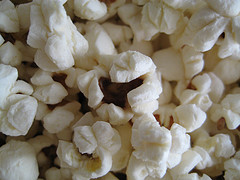 Why does popcorn cost so much at cinemas?
Why does popcorn cost so much at cinemas?
Physorg has a post on why:
New research from Stanford and the University of California, Santa Cruz suggests that there is a method to theaters’ madness–and one that in fact benefits the viewing public.
By charging high prices on concessions, exhibition houses are able to keep ticket prices lower, which allows more people to enjoy the silver-screen experience.
The findings empirically answer the age-old question of whether it’s better to charge more for a primary product (in this case, the movie ticket) or a secondary product (the popcorn).
Putting the premium on the “frill” items, it turns out, indeed opens up the possibility for price-sensitive people to see films.
That means more customers coming to theaters in general, and a nice profit from those who are willing to fork it over for the Gummy Bears.
They go on to say:
Movie exhibition houses rely on concession sales to keep their businesses viable.
Although concessions account for only about 20 percent of gross revenues, they represent some 40 percent of theaters’ profits.
That’s because while ticket revenues must be shared with movie distributors, 100 percent of concessions go straight into an exhibitor’s coffers.
Edward Jay Epstein also wrote about the economics of popcorn back in 2006.
He observed that cinemas are three different businesses:
- Fast food (popcorn, ice creams and nachos)
- Movies (the film you see)
- Advertising (those ads you sit through before the main feature)
He also makes the point that the popcorn, snacks and sodas you buy in the theatre lobby are a key part of how cinemas turn a profit:
This is an extremely profitable operation in which the theaters do not split the proceeds with the studios (as they do with ticket sales).
Popcorn, for example, because of the immense amount of popped bulk produced from a relatively small amount of kernels – the ratio is as high as 60:1 – yields more than 90 cents of profit on every dollar of popcorn sold.
It also serves to make customers thirsty for sodas, another high-margin product (supplied to most theater chains by Coca-Cola, which makes lucrative deals with theater owners in return for their exclusive “pouring” of its products.)
One theater chain executive went so far as to describe the cup holder mounted on each seat, which allows customers to park their soda while returning to the concession stand for more popcorn, as “the most important technological innovation since sound.”
But what about the choice between salt and sugar or even the gloopy butterscotch stuff?
There’s a reason for that too:
He also credited the extra salt added into the buttery topping on popcorn as the “secret” to extending the popcorn-soda-popcorn cycle throughout the movie.
For this type of business, theater owners don’t benefit from movies with a gripping or complex plot, since that would keep potential popcorn customers in their seats. “We are really in the business of people moving,” Thomas W. Stephenson, Jr., who then headed Hollywood Theaters, told me. “The more people we move past the popcorn, the more money we make.”
So there you have it – there’s more to cinema snacks than you might think.
> Find out more about Popcorn at Wikipedia
> More articles on Hollywood by Edward Jay Epstein